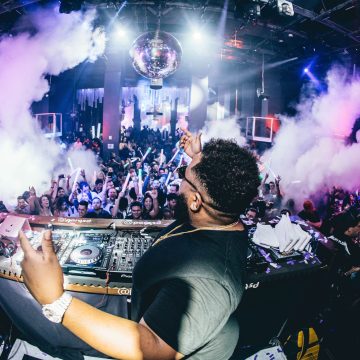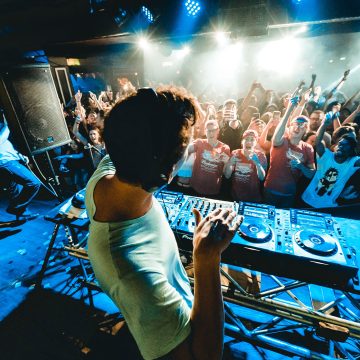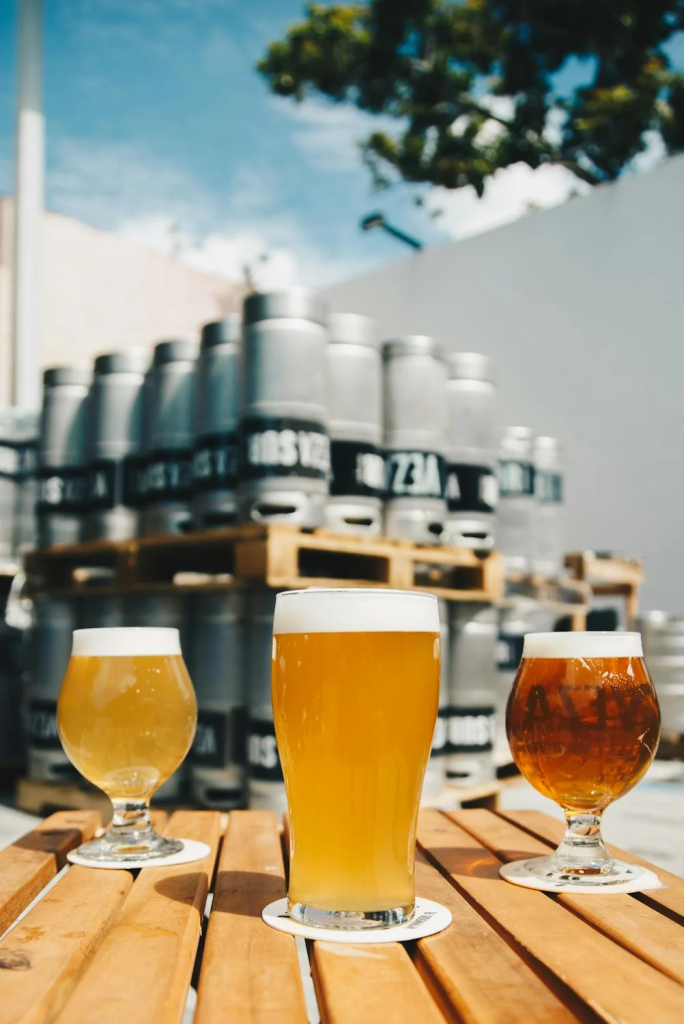BMGSEC
Music blogs
October 25, 2024
October 5, 2024
October 1, 2024
September 18, 2024
August 20, 2024
August 7, 2024
June 19, 2024
01
the lineup

Martin Garrix
Top 1 DJs Mag

Tiesso
Top 5 DJs Mag

DJ Hardwell
Top 10 DJs Mag

Tiesso
Top 5 DJs Mag

Walker
Top 1 DJs Mag

Alan
Top 1 DJs Mag
November 2, 2024
Melbourne, often celebrated for its vibrant cultural scene, lively food markets, and rich café culture, is also gaining recognition in the world of wine. For many wine enthusiasts, Australia’s renowned wine regions—such as the Barossa Valley in South Australia or the Margaret River in Western Australia—are the primary destinations.

However, Melbourne offers a distinctive wine experience that has grown significantly over recent years. Surrounded by excellent wine-producing areas, Melbourne has positioned itself as a major player in Australia’s wine industry. But can Melbourne itself be classified as a wine region?
Let’s delve deeper to understand Melbourne’s role in the wine world and discover nearby regions that have helped shape its wine identity.
Is Melbourne A Wine Region?
Melbourne itself is not a wine-producing region in the strictest sense. Most urban areas don’t have the vast vineyards or expansive farmlands necessary to produce wine on a large scale. However, Melbourne acts as a central hub for wine tourism and wine culture, with proximity to some of Australia’s most celebrated wine regions.
Many of these renowned areas, including the Yarra Valley, Mornington Peninsula, and Macedon Ranges, are located just a short drive from Melbourne. This close accessibility allows Melbourne to serve as a gateway for visitors looking to explore these premier wine destinations.
The Yarra Valley, located approximately an hour’s drive from Melbourne, is one of Australia’s oldest and most prestigious wine regions, known especially for its exceptional cool-climate wines. The region’s history of winemaking dates back to the early 19th century, and it produces varieties that are renowned worldwide, such as Chardonnay, Pinot Noir, and sparkling wines.
Similarly, the Mornington Peninsula to the south of Melbourne is famous for its Pinot Noir and other cooler-climate wines, while the Macedon Ranges offers some of the highest-altitude vineyards in Victoria, producing a variety of elegant, balanced wines.
These regions collectively contribute to Melbourne’s wine reputation, bringing both wine aficionados and casual visitors alike to sample their offerings.
Additionally, Melbourne has embraced wine culture within its city limits. The city boasts a large number of wine bars, cellars, and restaurants that pride themselves on offering local wines from these surrounding areas. From boutique wine shops to high-end dining establishments, Melbourne is a place where one can appreciate a diversity of wines without ever leaving the city.
The city also hosts several wine festivals throughout the year, including the Melbourne Food & Wine Festival, which showcases wines from across Victoria and beyond. So while Melbourne may not be a wine region by definition, its role as an epicenter for Australian wine culture is unmistakable.
What Are The Top Wine Regions Near Melbourne?
Though Melbourne itself doesn’t have vineyards within city limits, it’s perfectly positioned to access several top-notch wine regions within an hour or two’s drive. Here’s a look at some of the must-visit wineries in melbourne:
Yarra Valley
The Yarra Valley is Melbourne’s most famous neighbouring wine region, located just 50 kilometres east of the city. Known for its cooler climate, the valley is ideal for producing delicate wines like Pinot Noir, Chardonnay, and sparkling varieties. With over 160 wineries, the Yarra Valley is home to some of Australia’s most respected winemakers, including Domaine Chandon, De Bortoli, and Yering Station.
Visitors to the Yarra Valley can enjoy a blend of wine tastings, vineyard tours, and exceptional food. Many wineries offer gourmet restaurants on-site, where locally sourced ingredients are paired perfectly with wines made just steps away. Besides wine, the Yarra Valley is also known for producing artisanal cheeses, chocolates, and ciders, making it a gastronomic haven for visitors.
Mornington Peninsula
South of Melbourne, the Mornington Peninsula is another cool-climate wine region famous for its Pinot Noir and Chardonnay. This scenic area, about an hour from Melbourne, offers a coastal backdrop that enhances the experience of wine tasting. Wineries in the Mornington Peninsula tend to be smaller and boutique in nature, giving visitors a more intimate and personalized experience.
Popular wineries like Montalto, Ten Minutes by Tractor, and Red Hill Estate are known for their picturesque vineyards and high-quality wines. Beyond wine, the Mornington Peninsula is also famous for its beautiful beaches, hot springs, and culinary attractions.
Visitors can spend the day touring vineyards, relaxing in natural hot springs, or dining at top-rated restaurants, all with the breathtaking backdrop of the peninsula’s coastal landscapes.
Macedon Ranges
About an hour north of Melbourne, the Macedon Ranges is known for its high-altitude vineyards and distinctive, elegant wines. This region experiences one of the coolest climates in Australia, allowing winemakers to produce crisp, acidic whites and refined reds. The standout varieties in the Macedon Ranges include Riesling, Pinot Noir, and sparkling wines, which benefit from the area’s unique climate.
The region’s rugged beauty and cooler weather make it a refreshing contrast to other wine regions around Melbourne. With fewer crowds, the Macedon Ranges offers a quieter, more relaxed wine-tasting experience. Wineries like Hanging Rock Winery and Curly Flat Vineyards have become well-respected names in the area, drawing wine enthusiasts looking for something a little off the beaten path.
How Does Melbourne Celebrate Wine Culture?
Even though Melbourne doesn’t produce wine within the city, its residents and visitors can immerse themselves in a wine-centric culture. The city is filled with wine bars, festivals, and events that highlight the best wines from nearby regions, creating a lively wine scene right in the heart of the city.
Wine Bars And Restaurants
Melbourne is home to numerous wine bars that bring the nearby vineyards into the city. Spots like City Wine Shop, Bar Liberty, and Embla offer curated selections of local wines that allow patrons to sample some of the best bottles from Yarra Valley, Mornington Peninsula, and beyond. Many of these establishments focus on smaller producers, showcasing limited-edition wines and niche varieties that are not widely available.
In addition, Melbourne’s fine dining restaurants, such as Attica and Vue de Monde, are known for their carefully curated wine lists that pair local wines with seasonal dishes. This has allowed Melbourne’s wine bars and restaurants to serve as ambassadors for the surrounding wine regions, making it easy to appreciate local wines without leaving the city.
Wine Festivals And Events
Melbourne hosts several wine festivals throughout the year, which are perfect opportunities for wine lovers to engage with local wineries and sample a wide variety of wines. The Melbourne Food & Wine Festival is one of the most anticipated events, showcasing wines from across Victoria and attracting visitors from around the world.
This festival features wine tastings, masterclasses, and food pairings, offering a deep dive into Victoria’s wine scene.
Other popular events include the Winter Wine Weekend on the Mornington Peninsula and the Yarra Valley’s Shedfest, both of which provide visitors with a chance to experience wines from specific regions.
These events have become a cornerstone of Melbourne’s wine culture, giving attendees access to tastings, live music, and local food. Through these festivals and events, Melbourne has cultivated a wine-loving community that continues to grow each year.
Conclusion
While Melbourne may not technically be a wine region with its vineyards, it plays an undeniably central role in Australia’s wine culture. Surrounded by premier wine regions like the Yarra Valley, Mornington Peninsula, and Macedon Ranges, Melbourne serves as an accessible gateway for anyone looking to explore some of Australia’s finest wines.
With a thriving wine bar scene, high-end restaurants, and annual festivals, Melbourne has cultivated a vibrant wine culture that allows both locals and tourists to savour the region’s offerings without venturing far. So, while Melbourne itself may not produce wine, its role in connecting people with the wines of Victoria is irreplaceable.
Whether you’re a casual wine drinker or a dedicated connoisseur, Melbourne’s rich wine scene ensures there’s always something new to explore, sip, and savour.
October 25, 2024
Sydney is globally renowned for its dazzling nightlife, offering a mix of rooftop bars, live music, bustling clubs, and intimate cocktail lounges. With its diverse venues and lively ambience, it’s no surprise that Sydney’s night scene attracts locals and tourists alike, seeking everything from high-energy parties to laid-back lounges with a view.

But with so many districts and options available, you may wonder: where exactly is the heart of Sydney’s nightlife? In this guide, we’ll explore the standout areas for nightlife, the unique experiences they offer, and what each location brings to the table.
Which Area In Sydney Has The Best Nightlife?
When it comes to nightlife, Kings Cross is often hailed as Sydney’s most iconic after-dark destination. Known as “The Cross,” this area has been a nightlife hub since the early 20th century, and it retains a reputation for energetic, sometimes gritty, entertainment. The neighbourhood has evolved to attract a mix of people seeking everything from the trendiest nightclubs to hidden underground bars.
Kings Cross underwent a major shift in 2014, following the introduction of “lockout laws” aimed at curbing alcohol-related violence. These laws meant earlier closing times for bars and restricted entry hours, which led to a noticeable decline in nightlife.
However, the area has since adapted and diversified, and with the easing of restrictions in 2021, Kings Cross is once again thriving with a variety of upscale and bohemian venues.
Along Darlinghurst Road and William Street, visitors can find a collection of hip cocktail lounges, lively pubs, and famous clubs like The World Bar and Kings Cross Hotel. The World Bar, known for its quirky decor and teapot cocktails, creates a playful atmosphere, while the Kings Cross Hotel delivers an eclectic mix of live music, rooftop views, and unique décor across its six levels.
These spots ensure that visitors can have an unforgettable evening, whether they’re seeking dancing, socializing, or a bit of both.
Kings Cross also attracts a wide-ranging crowd, from backpackers and international students to professionals unwinding after work. The energy in the streets, combined with its eclectic venues, cements Kings Cross as one of Sydney’s top choices for nightlife.
The Rocks: Heritage Vibes With A Modern Twist
For those looking for something a little different, The Rocks offers a unique nightlife experience that combines Sydney’s historic charm with modern nightlife spots. Nestled just under the Sydney Harbour Bridge, The Rocks is a blend of colonial-era architecture, narrow alleyways, and cobbled streets—a perfect backdrop for a night out in Sydney.
The Rocks provide a range of options for an evening adventure. For a sophisticated atmosphere, The Glenmore Hotel offers an iconic rooftop bar with unbeatable views of the Sydney Opera House and Harbour Bridge.
With both indoor and outdoor seating, it’s a prime spot for enjoying a drink while soaking in the panoramic cityscape. During the weekend, the bar is abuzz with live music and a vibrant crowd.
Those interested in a bit of history can explore The Argyle, a historic sandstone venue that features five distinct bars within its walls. Originally built as a warehouse,
The Argyle maintains its original structure but with the addition of a bustling nightclub on weekends, making it a go-to spot for partygoers in The Rocks area. The atmosphere here shifts from relaxed dining in the early evening to a high-energy dance scene after dark, attracting a mix of tourists and locals.
In The Rocks, you can expect a mix of sophisticated lounges, quirky pubs, and high-energy dance floors. The area is especially popular for a laid-back night out, and with its scenic views and unique venue settings, it offers an excellent alternative to the city’s busier club scenes.
Darling Harbour: Waterside Lounges And Entertainment Venues
For a more polished and contemporary experience, Darling Harbour delivers a range of stylish bars, waterfront lounges, and entertainment venues. Known for its picturesque views and festive atmosphere, Darling Harbour is an excellent choice for those looking for a more upscale evening.
The area offers something for everyone—from relaxed lounges to bustling restaurants and a few nightclubs with scenic settings.
One of Darling Harbour’s most popular spots is Cohibar, a Cuban-inspired cocktail lounge known for its mojitos, waterfront views, and retro ambience. Cohiba is ideal for those wanting to enjoy expertly crafted cocktails while taking in the illuminated cityscape. The lounge also features a dance floor and hosts live DJs, creating an upbeat atmosphere without the intensity of a traditional nightclub.
If you’re looking to pair your night out with a delicious meal, Nick’s Seafood Restaurant offers a variety of Australian seafood in a lively waterfront setting. The lively ambience combined with the opportunity to savour fresh seafood makes it a favourite among visitors to Darling Harbour.
For larger groups, Cargo Bar provides an expansive space with both indoor and outdoor seating, making it ideal for casual gatherings or bigger events.
During the weekend, Darling Harbour’s energy is especially vibrant, with its bars and restaurants drawing a diverse crowd. The area’s combination of scenic views, premium cocktails, and contemporary settings make it a sophisticated option for a night out in Sydney.
Is Sydney Worth To Visit?
Sydney is worth a visit. Known for its iconic landmarks like the Sydney Opera House and Sydney Harbour Bridge, the city offers an incredible mix of natural beauty, cultural richness, and vibrant urban life. Whether you’re relaxing on the sun-soaked shores of Bondi Beach, exploring the historic charm of The Rocks, or diving into the nightlife of Kings Cross, Sydney has something for everyone.
The city’s neighbourhoods are as diverse as its food and entertainment scenes, making it a welcoming place for all types of travellers. With stunning beaches, bustling markets, scenic coastal walks, and world-class dining, Sydney captures the essence of both adventure and relaxation, creating a truly unforgettable travel experience.
Sydney captivates visitors with its natural beauty and urban sophistication, making it an ideal destination for a well-rounded getaway. The city boasts breathtaking beaches like Bondi and Manly, where locals and tourists alike enjoy surfing, swimming, and sunbathing.
Beyond its coastlines, Sydney is surrounded by lush national parks like the Blue Mountains and Royal National Park, offering outdoor enthusiasts endless trails, waterfalls, and dramatic landscapes to explore. These areas make Sydney unique, providing both metropolitan excitement and serene natural escapes within a short distance.
Conclusion
Sydney’s nightlife is as diverse as its population, offering everything from bohemian bars and historic pubs to stylish cocktail lounges with unforgettable views. Kings Cross, The Rocks, and Darling Harbour each bring something unique to Sydney’s nightlife scene.
Kings Cross maintains its reputation as an adventurous, edgy destination; The Rocks offers a blend of history and modernity; and Darling Harbour provides an upscale experience with a waterside charm.
No matter your mood or preference, Sydney’s nightlife has something to offer every visitor. The city’s nightlife areas not only reflect the diversity and culture of Sydney but also provide an environment where people from all walks of life can enjoy an evening out.
Whether you’re a local exploring new spots or a traveller seeking to experience the city’s vibrant after-hours scene, these districts showcase the best of what Sydney has to offer after dark.
For more information, click and visit the la salut redfern, today!
October 5, 2024
Melbourne, Australia, has earned its reputation as a vibrant cultural capital, known for its eclectic mix of food, art, and drink. Among the city’s hidden treasures lies its growing distillery scene, a reflection of Australia’s increasing fascination with craft spirits.

While wine regions like the Yarra Valley have long dominated the local beverage industry, Melbourne’s distilleries have surged in popularity, producing everything from world-class gins to premium whiskies.
The city’s thriving distillery culture is a must-explore for any spirit enthusiast. In this article, we’ll explore the largest distillery in Melbourne, as well as a few others worth visiting. We’ll also delve into what makes Melbourne’s distilleries so unique and what to expect when visiting them.
What Is The Largest Distillery In Melbourne Australia?
The largest distillery in Melbourne is none other than Starward Distillery, a renowned name in the Australian craft spirits industry. Starward Distillery has rapidly risen to fame since its founding in 2007 by David Vitale, an ambitious entrepreneur with a passion for whisky.
Located in the vibrant suburb of Port Melbourne, this distillery stands out not only for its sheer size but also for its innovative approach to whisky production.
Starward’s key innovation lies in its use of Australian wine barrels, particularly from local wineries in the Barossa Valley and the Yarra Valley, to age its whiskies.
This method imparts distinct flavours, making Starward’s whiskies a true reflection of the country’s terroir. By utilizing red wine barrels to age its spirits, the distillery creates whiskies that carry fruity, bold, and complex flavours not typically found in Scotch or American whiskies.
With a production capacity that outpaces any other distillery in the city, Starward’s commitment to quality and consistency has paid off.
The distillery has won numerous international awards, including the prestigious title of “Most Awarded Distillery of the Year” at the San Francisco World Spirits Competition in 2022. Starward Distillery is not only the largest in Melbourne but also one of the most influential, helping to cement Australia’s position on the global whisky map.
Visitors to Starward can enjoy tours that offer a behind-the-scenes look at the production process, from grain to glass. There are also tastings available, where guests can sample the distillery’s signature range, including Starward Nova, Solera, and Two-Fold, each offering unique tasting notes that highlight the distillery’s distinct aging methods.
Other Notable Distilleries To Visit In Melbourne
While Starward is the largest, Melbourne is home to several other impressive distilleries that have garnered attention both locally and internationally. These distilleries may not match Starward in size, but they certainly do in character and innovation.
Melbourne Gin Company (MGC)
The Melbourne Gin Company, established in 2012 by winemaker Andrew Marks, has become a favourite for gin lovers. Located an hour outside Melbourne in the picturesque Yarra Valley, MGC is known for producing handcrafted gins that use a variety of botanicals sourced both locally and globally.
MGC’s flagship gin, Melbourne Dry Gin, is a classic London dry style that blends 11 botanicals, including juniper, coriander seed, and native Australian ingredients like macadamia, sandalwood, and honey lemon myrtle.
This unique mix of flavours makes MGC a standout in Australia’s gin scene. In addition to Melbourne Dry, the distillery offers Single Shot Gin and Rare Dry Gin, each offering a unique twist on the classic gin formula.
Visiting MGC offers a serene escape from the city, with tours that provide insights into both gin production and winemaking, thanks to the distillery’s close ties to the wine industry. Whether you’re a gin aficionado or a casual drinker, MGC offers an unforgettable experience with a taste of Melbourne’s craft spirit scene.
The Craft & Co Distillery
The Craft & Co Distillery, located in Collingwood, is a one-stop destination for all things artisanal. Combining a distillery, brewery, and restaurant under one roof, The Craft & Co is a hub for Melbourne’s craft food and drink culture. Established in 2015, this small-batch distillery is known for producing an array of spirits, including gin, vodka, and liqueurs.
One of their most popular products is The Craft & Co Gin, made using a blend of native Australian botanicals such as finger lime, lemon myrtle, and pepperberry. The distillery also produces seasonal and limited-edition spirits, making each visit a unique experience.
The Craft & Co stands out for its commitment to education and experimentation. It offers gin-making workshops, where visitors can create their gin blend using various botanicals. This hands-on approach has made The Craft & Co a popular destination for those who want to learn more about the distillation process while enjoying Melbourne’s vibrant food and drink scene.
Why Melbourne Is A Hub For Craft Distilleries
Melbourne’s distillery scene is growing rapidly, thanks to a perfect storm of factors that make the city an ideal location for craft spirit production. Here’s why Melbourne is becoming a hub for distilleries:
Access To High-Quality Ingredients
One of the key reasons behind Melbourne’s booming distillery scene is its proximity to high-quality local ingredients. Victoria, the state in which Melbourne is located, is home to fertile agricultural land that produces a variety of grains, fruits, and botanicals. This access to fresh, local produce allows distilleries to experiment with flavours and create unique, high-quality spirits.
For example, many of Melbourne’s distilleries use native Australian botanicals such as wattleseed, lemon myrtle, and finger lime, which are not commonly found in other parts of the world. These ingredients give Melbourne-made spirits a distinct flavour profile that sets them apart from those produced elsewhere.
A Culture Of Innovation
Melbourne has long been known for its culture of innovation, and this extends to its distillery scene. The city’s distillers are not afraid to push the boundaries of traditional spirit-making techniques, often blending global influences with local ingredients to create something entirely new.
Starward’s use of wine barrels for aging whisky is a prime example of this innovation, as is MGC’s incorporation of native Australian botanicals into their gins. Melbourne’s distilleries are constantly experimenting with new flavours, techniques, and production methods, ensuring that the city’s craft spirits remain fresh and exciting.
A Thriving Food And Drink Scene
Melbourne is often referred to as Australia’s food capital, and its thriving culinary scene has played a significant role in the success of its distilleries. The city’s bars, restaurants, and cafes are always on the lookout for unique, locally-produced spirits to serve their customers.
This demand for craft spirits has fueled the growth of distilleries, creating a symbiotic relationship between the city’s food and drink establishments and its distillers.
Moreover, Melbourne’s cocktail culture is booming, with bartenders eager to incorporate locally-made spirits into their creations. This has given Melbourne’s distilleries a platform to showcase their products, both within Australia and on the international stage.
Conclusion
Melbourne’s distillery scene is one of the most exciting and dynamic in Australia. At the heart of this growing industry is Starward Distillery, the largest and most renowned distillery in the city, producing world-class whiskies that have garnered international acclaim.
But Starward is just one part of Melbourne’s broader craft spirit landscape, with distilleries like Melbourne Gin Company and The Craft & Co also making waves.
Whether you’re a whisky connoisseur or a gin lover, Melbourne’s distilleries offer something for everyone. The city’s commitment to innovation, access to high-quality local ingredients, and thriving food and drink culture have all contributed to the rise of its craft spirits industry.
For visitors and locals alike, exploring Melbourne’s distilleries is an adventure in itself—a journey through the flavours and techniques that define the city’s unique take on spirit-making.
For more information, visit and click the little lon distillery.
October 1, 2024
Beer is one of the most popular beverages worldwide, loved for its diverse flavours, historical significance, and cultural impact. From ancient civilisations brewing rudimentary forms of beer to today’s craft breweries experimenting with innovative ingredients, beer has certainly come a long way.

However, while many enjoy beer, there is often confusion about the available types. One of the most commonly asked questions is: Are beer and lager the same thing? In this article, we’ll delve into this topic, breaking down the difference between beer and lager and exploring the unique characteristics that set them apart.
Are Beer And Lager The Same?
At first glance, the question seems simple, but it’s rooted in a common misconception. The answer is both yes and no. Beer is a general term for an alcoholic beverage made from fermented grains, water, hops, and yeast. Under this broad category, there are many styles and types, such as ales, stouts, porters, lagers, and more. So, while all lagers are technically beers, not all are lagers.
To better understand this, let’s look at the two primary categories of beer: ales and lagers. The main difference between them lies in the fermentation process, particularly the yeast used and the temperature at which the beer is brewed.
Yeast And Fermentation Process
The key factor distinguishing lager from other types of beer is the yeast used during fermentation. Ale yeasts (Saccharomyces cerevisiae) are top-fermenting, which means they float on top of the fermenting liquid and work at higher temperatures, typically between 60°F and 75°F (15°C and 24°C). This results in a faster fermentation, usually taking only a few days.
Lager yeasts (Saccharomyces pastorianus), on the other hand, are bottom-fermenting, meaning they sink to the bottom of the fermenting vessel and work at cooler temperatures, typically between 45°F and 55°F (7°C and 13°C). This slower, cooler fermentation process results in a smoother, crisper taste and usually takes several weeks to complete.
Flavor Profile Differences
Because of these fermentation differences, ales and lagers tend to have distinct flavour profiles. Ales are generally more complex, fruity, and robust, often featuring stronger aromas due to the quicker and warmer fermentation. Common ale varieties include IPAs (India Pale Ales), stouts, and porters, each with unique flavour notes that can range from bitter to sweet, depending on the hops and malt used.
Lagers, on the other hand, are known for their cleaner, crisper tastes with a more subtle flavour profile. Lagers tend to have fewer fruity esters than ales and are often described as refreshing and light. Popular examples of lagers include Pilsners, Helles lagers, and American adjunct lagers like Budweiser or Heineken.
While lagers may have a simpler flavour profile compared to ales, this simplicity allows the malt and hops to shine through in a balanced way.
What Are The Different Types Of Lager?
Now that we’ve established that lager is a type of beer, it’s important to note that there are various styles of lagers, each with its unique characteristics. Let’s explore some of the most well-known types:
Pilsner
- Pilsner is perhaps the most famous and widely consumed type of lager. Originating in the Czech Republic in the mid-19th century, it is a pale, golden beer known for its crisp, clean taste and moderate bitterness. Pilsners are typically brewed with noble hops, which contribute to their signature floral and spicy aroma. They are often lighter in body, making them an ideal choice for casual drinking, especially in warmer weather.
Helles Lager
- Hailing from Germany, the Helles Lager is a slightly maltier and less bitter version of the Pilsner. It has a golden colour, a smooth mouthfeel, and a subtle sweetness from the malt that balances the hop bitterness. Helles lagers are known for their easy drinkability, making them a staple in German beer culture.
Bock
- Bocks are strong, malty lagers that originated in Germany as well. They come in various substyles, such as Doppelbock (double bock), Maibock (a lighter, spring version), and Eisbock (an intensely concentrated version). Bocks are typically darker in colour, with flavours of caramel, toffee, and dark fruit. They tend to have a higher alcohol content than other lagers, making them more robust and full-bodied.
American Adjunct Lager
- This is the style most commonly associated with mass-produced beers in the United States, such as Budweiser, Coors, and Miller. American adjunct lagers use additional ingredients like rice or corn, which lighten the body and flavour of the beer. These lagers are known for their pale colour, mild flavour, and high carbonation, making them popular choices for casual consumption.
Each of these lager styles offers something unique, from the refreshing bitterness of a Pilsner to the rich maltiness of a Bock. Regardless of which style you choose, lagers generally share the characteristic of being smooth and easy to drink.
What Are The Most Popular Ales?
While lagers dominate the global beer market, ales hold their own with an array of popular and beloved styles. Let’s take a look at some of the most famous types of ales:
IPA (India Pale Ale)
- Perhaps the most iconic type of ale, IPAs are known for their strong hop bitterness and bold aromas, often featuring citrus, pine, or floral notes. They originated in England but gained massive popularity in the United States, where craft breweries have pushed the boundaries of hop-forward beer. The West Coast IPA is known for its intense bitterness, while the New England IPA offers a hazier, fruitier experience.
Stout
- Stouts are dark, rich ales that get their colour and flavour from roasted malt or barley. They are often associated with flavours of coffee, chocolate, and caramel. The most famous stout is Guinness, an Irish dry stout with a smooth, creamy texture. Other variations include imperial stouts (more robust) and oatmeal stouts (softer and creamier).
Porter
- Closely related to stouts, porters are dark ales with a slightly lighter body. They originated in London and typically have flavours of roasted malt, chocolate, and caramel. While stouts tend to be more robust, porters offer a more balanced profile with a smooth finish, making them an excellent choice for those who enjoy dark beers without the intensity of a stout.
Belgian Ale
- Belgium is famous for its rich beer culture, and Belgian ales are among the most distinctive in the world. These beers are often characterised by their fruity, spicy flavours, which are produced by the unique strains of yeast used during fermentation. Belgian ales include styles such as Tripel, Dubbel, and Saison, each offering a complex blend of flavours that can range from sweet and malty to tart and effervescent.
Conclusion
While beer and lager are related, they are not the same thing. Lager is a type of beer distinguished by its fermentation process, cooler temperatures, and bottom-fermenting yeast.
This results in a smoother, crisper taste that contrasts with the more complex and robust flavours found in ales. Both lagers and ales offer a wide range of styles, from light and refreshing to rich and hearty, ensuring that there’s a beer for every palate.
Whether you prefer the hop-forward bitterness of an IPA, the malty richness of a bock, or the smooth crispness of a Pilsner, the world of beer has something to offer everyone. So the next time you crack open a cold one, take a moment to appreciate the craftsmanship and history behind each sip!
For more information, click and read this guide “what is lagering”.
September 18, 2024
The beer garden is a beloved feature of pubs and bars around the world, serving as a communal space where patrons can enjoy drinks and socialize in an outdoor setting. The term “beer garden” may evoke images of sunny afternoons filled with laughter, clinking glasses, and the aroma of grilled food wafting through the air.

But have you ever wondered about the origins of this delightful concept? Why is it called a beer garden, and what makes it such a popular gathering spot? This article delves into the history, cultural significance, and evolution of beer gardens, revealing why they remain a cherished part of social life in many societies.
Why Is It Called A Beer Garden?
The concept of a beer garden has its roots in Germany, where it began as a practical solution to the challenge of brewing and serving beer in the warmer months. In the 19th century, breweries in Bavaria started to expand their facilities outdoors, creating shaded areas where customers could enjoy freshly brewed beer in a pleasant setting.
These outdoor spaces were designed to keep beer cool during the hot summer months and allowed patrons to relax while savouring their drinks.
The first recorded beer garden was established in Munich in the early 1800s. At that time, breweries had to comply with strict regulations regarding the sale of beer, particularly during the warmer months when spoilage could occur.
To circumvent these rules, brewers began offering their products in gardens and courtyards, which were often shaded by trees. This practice not only provided a suitable environment for cooling beer but also attracted patrons seeking a refreshing respite from the heat.
As the popularity of these outdoor spaces grew, so did their appeal as social hubs. Beer gardens quickly became known for their relaxed atmosphere, where people could gather to enjoy not only beer but also food, music, and companionship.
The idea of the beer garden spread throughout Germany and eventually made its way to other parts of Europe and the world, becoming an integral part of pub culture.
Beer Gardens Around The World
While the term “beer garden” originated in Germany, similar concepts have emerged in various cultures around the globe, each with its unique flair. Here’s a look at how different countries have embraced the beer garden concept:
The German Beer Garden Tradition
In Germany, beer gardens are typically associated with a communal dining experience. Many feature long, communal tables where patrons sit side by side, fostering a sense of community and camaraderie.
Traditional German beer gardens often serve hearty fare such as pretzels, sausages, and schnitzels, complemented by a wide selection of local beers. Events such as live music and folk dances are common, enhancing the festive atmosphere.
During major festivals like Oktoberfest, beer gardens play a central role, offering visitors a chance to sample a variety of brews while enjoying traditional German entertainment. The Bavarian beer garden remains a vibrant symbol of German culture, emphasizing the importance of social interaction and enjoyment of life.
The American Twist
In the United States, beer gardens have also gained popularity, particularly in urban areas. While they still maintain their communal aspect, American beer gardens often blend various influences, incorporating outdoor lounge seating, fire pits, and a diverse selection of craft beers. Many feature rotating taps that showcase local breweries, allowing patrons to sample new and unique flavours.
Food offerings in American beer gardens are equally varied, ranging from gourmet food trucks to classic barbecue fare. Some venues host trivia nights, live music, or outdoor movie screenings, catering to a wide range of tastes and preferences. This fusion of cultures has led to the evolution of the American beer garden into a versatile space that appeals to a diverse audience.
Beer Gardens In Australia and Beyond
Australia has embraced the beer garden concept with its unique twist. Often associated with a laid-back lifestyle, Australian beer gardens tend to emphasize outdoor relaxation. They frequently feature lush greenery, barbecues, and comfortable seating, making them ideal for long afternoons spent with friends.
In countries like the UK and Canada, beer gardens are similarly popular. The British version often includes outdoor patios attached to pubs, while in Canada, beer gardens are often found in public parks and festivals, allowing for community gatherings and celebrations.
The Cultural Significance Of Beer Gardens
The enduring popularity of beer gardens can be attributed to their ability to foster social connections and create a sense of community. In a world that increasingly emphasizes individualism and technology, these outdoor spaces offer a refreshing retreat, encouraging face-to-face interactions and shared experiences.
Community And Connection
At their core, beer gardens are places of gathering. They provide a welcoming environment where people from diverse backgrounds can come together, share stories, and forge connections over a cold drink. Whether it’s a group of friends catching up, families celebrating special occasions, or strangers striking up conversations, beer gardens facilitate meaningful interactions that transcend social barriers.
The communal tables and relaxed atmosphere invite camaraderie, allowing patrons to bond over their shared love of good beer and food. This sense of community is particularly evident during events and festivals, where the vibrant atmosphere draws people in and creates lasting memories.
A Retreat From Urban Life
In bustling urban environments, beer gardens serve as essential green spaces where individuals can escape the pressures of city life. Surrounded by nature, these gardens offer a calming respite from the noise and chaos of everyday routines. The combination of fresh air, natural surroundings, and the company of others can significantly enhance well-being and reduce stress.
Many beer gardens are strategically located in parks or gardens, providing patrons with a serene backdrop. The presence of plants, trees, and open skies creates a refreshing contrast to the concrete jungle, encouraging people to unwind and reconnect with nature.
Cultural Exchange
Beer gardens also play a vital role in cultural exchange. As they spread across different regions and countries, they adopt local customs, traditions, and flavours, creating unique experiences for patrons. This blending of cultures fosters an appreciation for diversity and introduces people to new culinary and brewing traditions.
In many beer gardens, you’ll find a mix of traditional dishes and innovative cuisine that reflects the local culture. This culinary fusion allows visitors to explore new flavours while enjoying familiar favourites, enriching the overall experience.
Conclusion
The beer garden is more than just a place to enjoy a drink; it embodies a rich history and cultural significance that has evolved. From its origins in Germany to its modern interpretations around the world, the beer garden continues to be a cherished social space where connections are forged, traditions are celebrated, and memories are made.
In an era where technology often overshadows face-to-face interactions, beer gardens remind us of the importance of community and shared experiences. They invite us to step outside, engage with others, and savour the simple pleasures of life. This communal atmosphere creates lasting bonds and promotes a sense of belonging that is increasingly valuable in our fast-paced world.
Moreover, beer gardens are adaptable spaces that can cater to various interests and demographics. Whether you’re looking for a lively gathering spot with live music or a quiet corner to relax with a good book, there’s likely a beer garden that fits the bill. This versatility ensures that beer gardens can thrive in different cultural contexts, offering something for everyone.
Are you looking for more information? Here’s to help you, click the best beer gardens melbourne, now!
August 20, 2024
Melbourne, known for its vibrant arts scene, diverse culinary offerings, and rich cultural tapestry, also boasts a dynamic nightlife.

Whether you’re a resident or a tourist, the city’s bar scene offers something for everyone—from hidden speakeasies to rooftop bars with stunning skyline views. The sheer variety of bars in Melbourne can be overwhelming, which raises an interesting question: how many bars are there in Melbourne?
How Many Bars Are There In Melbourne?
Determining the exact number of bars in Melbourne can be challenging due to the constant changes in the hospitality industry. New bars pop up while others close down, and different types of venues may or may not be classified as bars depending on their primary function.
However, as of recent estimates, Melbourne is home to over 1,000 bars, including pubs, clubs, cocktail lounges, and wine bars. This number fluctuates as the industry evolves, driven by trends, economic factors, and customer preferences.
These bars are not just concentrated in one area; they are spread across the city’s various neighbourhoods, each offering a unique atmosphere and experience.
The central business district (CBD) alone has hundreds of bars, ranging from upscale venues to laid-back pubs. Popular areas such as Fitzroy, Collingwood, and St Kilda are also known for their bustling bar scenes, providing a mix of trendy spots and hidden gems.
The diversity of Melbourne’s bar scene is one of its greatest strengths. Whether you’re looking for a quiet corner to enjoy a glass of wine or a lively venue with live music, Melbourne has it all. The city’s bars cater to a wide range of tastes and preferences, ensuring that there is always something new to explore.
What Makes Melbourne’s Bar Scene Unique?
Melbourne’s bar scene stands out for its creativity and diversity. The city is home to an eclectic mix of establishments that reflect its multicultural influences and innovative spirit. Here are a few elements that make Melbourne’s bar scene truly unique:
Hidden Bars And Speakeasies
One of the defining features of Melbourne’s nightlife is its hidden bars. These secretive spots are often tucked away in alleyways, behind unmarked doors, or in basements. The thrill of discovering a hidden bar adds an element of adventure to a night out in Melbourne.
Bars like Eau de Vie and The Croft Institute offer a unique experience that you won’t find anywhere else. The speakeasy trend has taken off in Melbourne, with bars embracing themes from the Prohibition era and creating intimate, dimly lit spaces where guests can enjoy expertly crafted cocktails.
Rooftop Bars With A View
Melbourne’s skyline is a sight to behold, and what better way to enjoy it than from a rooftop bar? The city is known for its rooftop venues, which offer spectacular views, especially at sunset.
Rooftop bars like Rooftop at QT and Naked in the Sky provide not only great drinks but also stunning vistas of the city. These bars are particularly popular during the warmer months, offering a relaxed atmosphere where patrons can enjoy the fresh air and scenic views.
Themed And Specialty Bars
The creativity of Melbourne’s bartenders and bar owners is evident in the city’s themed and specialty bars. Whether it’s a bar dedicated to board games like Bartronica, a place where you can enjoy retro arcade games or a bar that specializes in gin like Gin Palace, Melbourne’s bars often offer more than just drinks.
These themed bars create immersive experiences that transport patrons to different times and places, enhancing the overall nightlife experience.
Focus On Local Ingredients And Sustainability
Many Melbourne bars are committed to sustainability and supporting local producers. From sourcing ingredients locally to minimizing waste, these bars are part of a growing movement towards environmentally conscious hospitality.
Bars like Byrdi and Above Board focus on seasonal ingredients and innovative techniques, ensuring that their cocktails are not only delicious but also sustainable. This focus on sustainability reflects Melbourne’s broader commitment to environmental stewardship and adds a unique dimension to its bar scene.
Must-Visit Bars In Melbourne
With so many bars to choose from, it can be hard to decide where to start. Here are a few must-visit bars in Melbourne that offer a taste of the city’s diverse nightlife:
- Eau de Vie: This speakeasy-style cocktail bar is renowned for its inventive drinks and intimate atmosphere. Located in the heart of the CBD, Eau de Vie transports you back to the Prohibition era with its classic decor and expertly crafted cocktails. The bar’s extensive menu features a wide range of spirits and a selection of signature cocktails that are sure to impress.
- The Everleigh: Another gem in Melbourne’s bar scene, The Everleigh is known for its elegant setting and commitment to quality. The bar offers a curated selection of classic cocktails, each made with precision and care. The Everleigh’s focus on craftsmanship and attention to detail make it a must-visit for cocktail enthusiasts.
- Naked for Satan: Located in Fitzroy, Naked for Satan is a rooftop bar with a difference. The venue offers a range of affordable drinks and a menu of pintxos (Basque-style tapas) that are perfect for sharing. The bar’s relaxed vibe and panoramic views of the city make it a popular spot for both locals and tourists.
- Bar Americano: If you’re looking for a truly unique experience, Bar Americano is the place to go. This tiny bar, located down a laneway in the CBD, is modelled after a classic European aperitivo bar. With a standing-room-only policy and a rotating menu of cocktails, Bar Americano offers an intimate and authentic drinking experience.
The Evolution Of Melbourne’s Bar Scene
Melbourne’s bar scene has evolved significantly over the years, shaped by changes in consumer preferences, cultural influences, and regulatory frameworks. The city’s nightlife has come a long way from its early days, and today, it is known for its dynamic and ever-changing bar landscape. Here are a few key trends that have shaped the evolution of Melbourne’s bar scene:
- The Rise of Cocktail Culture: In recent years, there has been a growing interest in craft cocktails and mixology in Melbourne. Bartenders are increasingly viewed as artists and innovators, with many bars focusing on the art of cocktail-making. This trend has led to the rise of cocktail bars that emphasize creativity, quality ingredients, and presentation.
- A Shift Towards Experiential Drinking: Melbourne’s bar-goers are increasingly seeking out unique and immersive experiences. Whether it’s a hidden speakeasy, a rooftop bar with a view, or a themed bar that transports you to another era, the focus is now on creating memorable experiences. This shift towards experiential drinking has led to the proliferation of concept bars and venues that offer more than just places to drink.
- Emphasis on Local and Sustainable Practices: As mentioned earlier, sustainability has become a key focus for many Melbourne bars. There is a growing emphasis on sourcing local ingredients, minimizing waste, and adopting environmentally friendly practices. This trend reflects a broader shift towards conscious consumption and has influenced the way many bars operate.
Conclusion
Melbourne’s bar scene is a vibrant and diverse tapestry that reflects the city’s rich cultural heritage and innovative spirit. With over 1,000 bars to choose from, there’s no shortage of options for those looking to explore the city’s nightlife.
From hidden speakeasies and rooftop bars to themed venues and sustainable cocktail lounges, Melbourne offers a unique and dynamic bar experience that caters to all tastes and preferences.
Whether you’re a local looking to discover a new favourite spot or a visitor eager to experience the best of Melbourne’s nightlife, there’s always something new and exciting to explore. So, next time you find yourself in Melbourne, be sure to raise a glass and toast to the city’s incredible bar scene. Cheers!
August 7, 2024
Fans of male strip shows can experience the thrill and mystery of “Magic Men” live in Australia. The Magic Men are popular for hen parties, girls’ nights out, and other special events thanks to their exciting atmosphere, captivating performers, innovative combination of choreographed dance routines, themed costumes, and interactive entertainment.

As a result of its concentration on giving a wonderful night of fun and imagination, Magic Men has risen to the ranks of the most popular male revue shows, enthralling audiences with its appealing charisma and remarkable stage presence.
Is Magic Men A Strip Show?
A strip show is exactly what Magic Men is. The male dancers in this renowned revue show often strip down to their underwear as they execute rehearsed routines.
The show’s target audience is adults, so it’s perfect for stag and bachelorette parties. Magic Men performances are always exciting and entertaining because of the themes, costumes, and audience participation. Here are a few more examples of popular male revue strip shows:
- Thunder From Down Under: An Australian male revue show that is internationally famous. The show features muscular male dancers who perform in various themed costumes, engaging in choreographed routines that often include stripping.
- Chippendales: One of the most iconic male strip shows, Chippendales started in the 1970s and has become a global brand. Their shows are known for elaborate costumes, highly choreographed dance routines, and interaction with the audience.
- Magic Mike Live: Inspired by the “Magic Mike” films, this live show created by Channing Tatum features a cast of male dancers performing seductive routines. The show is known for its high production value, with a mix of dance, acrobatics, and audience participation.
- Men of Vegas: A male revue show based in Las Vegas, known for its energetic performances and diverse cast of male dancers who perform various themed routines, often incorporating stripping.
- Hollywood Men: A male revue show in Los Angeles that offers high-energy performances with male dancers who strip down as part of their routines. The show is popular for bachelorette parties and girls’ nights out.
These shows are generally aimed at female audiences and are often used as entertainment for events like hen parties or birthday celebrations.
Are Male Strippers Available In Brisbane?
Yes, male strippers are available in Brisbane. Several services and entertainment companies offer male strippers for events such as hen parties, birthdays, or girls’ nights out. Some of the popular male stripper brisbane are included:
- Magic Men: This well-known male revue show operates in Brisbane and offers both live performances and private bookings for events.
- Hunks4Hire: A company that specializes in male strippers for private events, offering a variety of themes and performance styles.
- Badboys Australia: Another popular male revue show that tours across Australia, including Brisbane, and also offers private bookings for special events.
- Aussie Hunks: They provide male strippers and dancers for parties and events in Brisbane, known for their interactive performances and professional entertainers.
These services usually allow you to choose from different themes, costumes, and performance styles to suit your event. Booking in advance is recommended, especially for popular dates and events.
What To Wear To The Magic Men Show?
When attending a Magic Men show, the key is to wear something that makes you feel comfortable, confident, and ready to enjoy a fun night out. Here are some outfit ideas based on the atmosphere and vibe of the show:
For Women
- Chic Casual: A stylish top paired with jeans or a skirt is a great option. Add some heels or trendy flats to complete the look.
- Cocktail Dress: A little black dress or a colourful cocktail dress is perfect if you want to dress up a bit more for the occasion.
- Playful and Fun: Consider wearing something fun and flirty, like a romper or a jumpsuit. This is great for those who want to keep it casual yet stylish.
- Accessorize: Bring some fun accessories, like statement earrings, a bold clutch, or even a tiara if you’re celebrating something special.
For Men
- Smart Casual: A nice button-up shirt with jeans or chinos is a good choice. Pair it with dress shoes or stylish sneakers.
- Casual: If the venue is more relaxed, a well-fitted t-shirt with jeans and clean sneakers can work just fine.
- Add Some Flair: If you’re attending as part of a special celebration (like a bachelor party), you might want to wear something themed or a fun accessory.
The goal is to feel great and enjoy the lively atmosphere of the show, so choose an outfit that suits the occasion and your style.
What Is The Purpose Of Magic Show?
The purpose of a magic show is to entertain and captivate an audience by creating a sense of wonder and amazement through the performance of illusions and tricks. These performances often involve sleight of hand, mentalism, and other forms of deception that challenge the audience’s perception of reality. The main objectives of a magic show include:
- Entertainment: Magic shows are designed to be fun and engaging, providing an enjoyable experience for audiences of all ages.
- Wonder and Amazement: By performing tricks that seem impossible, magicians aim to evoke a sense of wonder and amazement, leaving the audience in awe of what they’ve witnessed.
- Suspension of Disbelief: A magic show encourages the audience to temporarily suspend their disbelief and immerse themselves in a world where the impossible seems possible.
- Interactive Experience: Many magic shows involve audience participation, making the experience more immersive and memorable.
- Showcasing Skill: Magicians often use their shows to demonstrate their skill, creativity, and mastery of illusion, showcasing the art of magic as a form of performance art.
- Storytelling: Some magic shows incorporate storytelling elements, using illusions to convey a narrative or message, adding depth to the performance.
The purpose of a magic show is to entertain, mystify, and bring joy to audiences, creating an experience that leaves a lasting impression.
How Long Should A Magic Show Last?
The ideal length of a magic show can vary depending on the type of event, audience, and format of the performance. Here are some general guidelines for different types of magic shows:
Stage Magic Show
- Duration: 60 to 90 minutes
- Details: A full-stage magic show typically lasts around an hour to an hour and a half, often with an intermission. This length allows for a variety of tricks and routines, building up to a grand finale.
Close-Up Magic Show
- Duration: 30 to 60 minutes
- Details: Close-up magic shows, where the magician performs tricks near a small audience or at tables, generally last between 30 minutes to an hour. This format is more intimate and often used at private events or receptions.
Children’s Magic Show
- Duration: 30 to 45 minutes
- Details: Children’s magic shows are typically shorter, around 30 to 45 minutes, as younger audiences tend to have shorter attention spans. The show is often fast-paced with simple, colorful tricks to keep the kids engaged.
Corporate Magic Show
- Duration: 45 to 60 minutes
- Details: Corporate magic shows, performed at company events or conferences, usually last about 45 to 60 minutes. These shows may include customized content related to the company’s message or theme.
Street Magic or Strolling Magic
- Duration: Varies (10-15 minutes per set)
- Details: For street magic or strolling magic, where the magician performs for small groups in informal settings, the duration of each set is usually about 10 to 15 minutes. The magician can perform multiple sets over some time.
Magic Show at a Festival or Fair
- Duration: 20 to 30 minutes
- Details: At a festival or fair, magic shows are often shorter, around 20 to 30 minutes, to cater to the transient nature of the audience, allowing people to come and go as they please.
A magic show should be long enough to provide a full, satisfying experience without overstaying its welcome, ensuring the audience remains entertained and engaged throughout.
Conclusion
To make the most of the occasion, the audience, and the location, the duration of a magic show should be thoughtfully customized. No matter the size of the performance—a full-stage show that can run up to 90 minutes, a short, dynamic set for a festival or corporate event, or a more intimate close-up presentation that lasts 30 to 60 minutes—the goal is to enthral and astound the audience.
Magicians may design an unforgettable performance that stays with spectators long after the last trick has been performed by thinking about things like audience demographics, event style, and tempo.
June 19, 2024
As a symbol of your undying devotion to one another, your wedding band will never go out of style. When looking for a wedding ring, it’s important to take your partner’s or your taste, as well as the band’s style and quality, into account. Find a wedding band that is as unique as your love story with the help of this comprehensive guide.

It will walk you through every step of the process, from comprehending different metals and designs to navigating budget concerns and customizing choices. Learn how to incorporate this major purchase into your wedding story in a meaningful way by reading expert advice, perusing current fashions, and more.
How do I Find A Good Wedding Band?
Finding a good wedding band involves several steps to ensure you choose one that fits your style, budget, and needs. Here are some tips to help you find the right wedding band:
- Define Your Budget: Determine how much you’re willing to spend. This will narrow down your options and help you focus on bands within your price range.
- Research Styles: Explore different styles of wedding bands. Consider factors like metal (gold, platinum, etc.), width, design (plain, engraved, diamonds, etc.), and whether you want a matching band to your engagement ring if applicable.
- Visit Jewelry Stores: Go to jewellery stores that specialize in wedding bands. This allows you to see and try on different styles in person.
- Ask for Recommendations: Seek recommendations from friends, family, or wedding planners who may know reputable jewellers or have experience with specific bands.
- Check Reviews: Look up online reviews for jewellers and specific bands you’re interested in. Reviews can provide insights into the quality and customer service of the jeweller.
- Consider Customization: If you have a specific design in mind or want something unique, inquire about customization options. Many jewellers offer customization services to create a personalized wedding band.
- Check Policies: Review the store’s policies on resizing, returns, warranties, and maintenance. It’s important to know what to expect after purchasing your wedding band.
- Try It On: Before making a final decision, try on the wedding bands you’re considering. Pay attention to comfort, fit, and how well it complements your engagement ring if you have one.
- Quality and Certification: Ensure that the wedding band meets quality standards. Look for certifications for diamonds or other gemstones if applicable.
- Plan Ahead: Start looking for a wedding band well in advance to allow time for any customizations or adjustments needed.
By following these steps, you can find a wedding band that suits your style and preferences, ensuring a meaningful and lasting symbol of your marriage.
What Is The Purpose Of Hiring A Wedding Band?
The purpose of hiring a wedding band is multifaceted and can vary based on individual preferences and the overall ambience desired for the wedding. Here are several key purposes:
- Live Entertainment Experience: A wedding band offers live music, creating a vibrant and engaging atmosphere that enhances the overall experience for guests. Live music can bring energy and excitement to the event, making it memorable and enjoyable.
- Personalized Music Selection: Unlike recorded music or a DJ playlist, a wedding band can tailor their performance to suit the couple’s musical preferences and the mood of the wedding. They can perform special requests, adapt their setlist based on the crowd’s response, and create a personalized musical journey throughout the event.
- Professionalism and Skill: Experienced wedding bands bring professionalism and musical skill to the table. They are trained performers who can entertain and engage the audience with their talent, ensuring high-quality musical entertainment.
- Creating a Unique Atmosphere: A live band adds a unique charm and sophistication to the wedding ambience. Their presence and performance style contribute to the overall aesthetic and atmosphere of the event, making it feel more special and memorable.
- Emotional Impact: Live music has a powerful emotional impact. It can evoke feelings of joy, romance, nostalgia, and celebration, resonating deeply with the couple and their guests. This emotional connection can enhance the significance of the wedding day.
- Entertainment for Guests: Wedding bands provide entertainment not only for the couple but also for their guests. They encourage dancing, interaction, and enjoyment among attendees, fostering a lively and festive atmosphere.
Hiring a wedding band enhances the wedding experience by providing personalized, live musical entertainment that complements the couple’s style and creates lasting memories for everyone involved.
When Should I Hire a Wedding Band?
You should consider hiring a wedding band when you want to elevate the entertainment experience at your wedding and create a memorable atmosphere through live music. Here are some key considerations for when to hire a wedding band:
- Personal Preference: If you and your partner value live music and want to create a lively, engaging atmosphere at your wedding, a wedding band could be a great choice. Live music adds a unique charm and personal touch to the event.
- Wedding Theme and Style: If your wedding has a specific theme or style that would be complemented by live music, such as a vintage theme, a classical affair, or a rustic celebration, a wedding band can enhance the overall ambience and aesthetics.
- Size of the Venue: Consider the size of your wedding venue. A wedding band works well in medium to large venues where their sound can fill the space and create a dynamic atmosphere. For smaller venues, ensure the band can adjust their volume accordingly.
- Budget Considerations: Wedding bands typically require a higher budget compared to a DJ or recorded music. If live music is a priority and fits within your budget, hiring a band can be a worthwhile investment to enhance the overall experience for you and your guests.
- Guest Experience: If you want to ensure your guests have a memorable and enjoyable experience, live music provided by a skilled wedding band can encourage dancing, interaction, and a festive atmosphere throughout the celebration.
- Availability and Planning: Start planning early and book the band well in advance, especially if you have a specific band in mind or if they are popular and tend to get booked quickly during the wedding season.
The decision to hire a wedding band depends on your personal preferences, budget, venue size, and the overall atmosphere you want to create for your wedding day.
Conclusion
Having a wedding band perform live music that is meaningful to you, your spouse, and your guests is a great way to liven up your big day. In addition to providing musical entertainment, a wedding band may help set the mood, inject energy into the reception, and personalize the event.
Picking the perfect wedding band can transform your reception into an unforgettable celebration brimming with love, joy, and cherished memories, whether you value live music for its emotional impact, its versatility in creating the soundtrack of your dream wedding, or its ability to captivate and involve your guests.
An emotional, stylish, and celebratory thread is woven into the fabric of your wedding day by the choice to hire a wedding band. A live band does more than just play music; they bring an exciting atmosphere that will carry over your whole event, from the touching moments of the ceremony to the exciting celebrations afterwards.
Each note will express your love story because of its capacity to customize the soundtrack, play the music that you want, and adjust to the current atmosphere.
Looking for a trusted wedding band for your special day? Click the official website and book your appointment today!
June 18, 2024
Whatever your singing endeavour—an audition for a professional gig, a chorus, or a musical theatre production—the experience may be thrilling and terrifying all at the same time. It’s an opportunity to showcase your singing skills, stage presence, and personal flair to people who can make decisions about your singing career.

It takes more than simply a good voice to ace an audition; what matters is knowing what to expect, having plenty of practice, and having a solid grasp of the process. Everything you need to know, from choosing the right song to performing with assurance, is right here in this guide to help you ace your next singing audition.
Whether you’re an experienced performer or this is your first audition, these tips will help you stand out.
How Do You Audition For Singing?
Auditioning for a singing role can be a pivotal moment in a singer’s career, providing opportunities to showcase talent, gain experience, and potentially land significant roles. Whether you’re aspiring to join a choir, secure a spot in a musical theatre production, or break into the music industry, a successful audition requires careful preparation and a strategic approach.
Here’s a step-by-step guide to help you navigate the audition process and maximise your chances of success:
Research and Selection
- Know the Requirements: Understand the specific requirements of the audition, such as the type of music, the length of the performance, and any particular skills or qualities sought by the judges.
- Choose the Right Song: Select a song that highlights your vocal strengths and is appropriate for the audition context. Avoid overly popular songs that might be overdone unless you can bring a unique twist to them.
Preparation and Practice
- Vocal Warm-Ups: Engage in regular vocal exercises to improve your range, tone, and control. Consistent warm-ups help prevent strain and keep your voice in top condition.
- Rehearse Thoroughly: Practice your chosen piece until you feel completely comfortable. Focus on difficult sections, and ensure you can perform the song without relying on lyrics or music sheets.
- Stage Presence: Work on your stage presence by performing in front of a mirror or recording yourself. Pay attention to your posture, facial expressions, and gestures to ensure you present confidently.
Audition Day Preparation
- Dress Appropriately: Wear an outfit that makes you feel confident and is suitable for the type of audition. Avoid clothing that is too casual or too distracting.
- Arrive Early: Plan to arrive at the audition venue well ahead of your scheduled time. This allows you to acclimate to the environment and reduce any last-minute stress.
During the Audition
- Stay Calm and Confident: Take a few deep breaths to calm your nerves before you begin. Maintain eye contact with the judges and project confidence.
- Engage with the Judges: Be polite and professional when interacting with the judges. Introduce yourself clearly, and provide any requested information about your piece before you start singing.
- Express Emotion: Convey the song’s emotions through your voice and expressions. Judges look for singers who can connect with the audience on an emotional level.
Post-Audition
- Reflect on Your Performance: After the audition, take some time to reflect on what went well and areas where you could improve. Use this feedback to enhance your preparation for future auditions.
- Follow-up: If appropriate, send a thank-you note to the judges or the audition organisers. Expressing gratitude can leave a positive impression and keep you in mind for future opportunities.
Auditioning for singing roles can be a daunting process, but with thorough preparation and the right mindset, you can turn it into a rewarding experience. Remember, each audition is a learning opportunity that brings you one step closer to your goals.
How To Practice For A Musical Audition?
Preparing for a musical audition requires a combination of vocal technique, acting skills, and confidence. Here’s a step-by-step guide to help you practice effectively and make a memorable impression:
Understand the Role and Show
- Research the Musical: Familiarize yourself with the musical, its plot, characters, and musical style. This helps you understand the context and emotional tone of the songs you’ll perform.
- Know the Character: Study the character you’re auditioning for. Understand their personality, motivations, and how they fit into the story. This will inform your performance and help you embody the role.
Select Appropriate Material
- Choose the Right Song: Pick a song that showcases your vocal range and fits the style of the musical. If possible, select a piece that aligns with the character you’re auditioning for.
- Prepare a Monologue: If the audition requires a monologue, choose one that complements the character and shows your acting abilities.
Vocal Preparation
- Warm Up Regularly: Start each practice session with vocal warm-ups to stretch and strengthen your voice. This includes scales, lip trills, and breathing exercises.
- Practice the Song: Break down the song into sections and practice each part until you’re comfortable. Focus on difficult passages and work on pitch, tone, and timing.
- Emotional Connection: Connect emotionally with the song. Understand the lyrics and the story behind them, and convey that emotion in your performance.
Acting and Movement
- Characterization: Work on your character’s mannerisms, voice, and physicality. Practice in front of a mirror to refine your portrayal.
- Blocking: Think about how you will move on stage. Plan and practice your movements to ensure they feel natural and enhance your performance.
- Facial Expressions: Use your face to express the emotions of the song. Practice in front of a mirror to ensure your expressions are clear and impactful.
Combine Singing and Acting
- Integrated Performance: Practice singing and acting simultaneously. Ensure that your vocal performance does not overshadow your acting, and vice versa.
- Run Throughs: Perform the song and monologue in full as you would in the audition. This helps you build stamina and confidence.
Feedback and Improvement
- Record Yourself: Record your practice sessions and review them to identify areas for improvement. Pay attention to both your vocal performance and acting.
- Seek Feedback: Get feedback from trusted friends, teachers, or coaches. Constructive criticism can help you refine your performance.
Final Preparations
- Memorize Your Material: Ensure you know your song and monologue by heart. This allows you to focus on your performance rather than worrying about remembering lines.
- Dress Rehearsal: Perform in your audition outfit to ensure it’s comfortable and suitable. This also helps you get into character.
Day of the Audition
- Stay Relaxed: Get a good night’s sleep before the audition and eat a healthy meal. Practice some light vocal warm-ups but avoid overworking your voice.
- Confidence and Positivity: Approach the audition with a positive mindset. Remember, the audition is an opportunity to showcase your talent and passion.
By following these steps, you can effectively prepare for a musical audition, demonstrating both your vocal prowess and your ability to inhabit a character.
Conclusion
It takes time, effort, and knowledge about the musical and the role you’re trying out for to be ready for an audition for a musical. You may provide a superb performance by studying the part well, choosing suitable material, and practising your acting and voice abilities. Make sure your audition is cohesive and emotionally impactful by combining your singing and acting skills.
The first stages to success are to ask for and implement constructive criticism, to work on your technique, and to keep a cheerful and assured attitude. If you want to be a musical theatre star, every audition is a stepping stone on the path to success. Let your enthusiasm for performing and faith in your ability guide you through the process. Wishing you the best of luck!
For more information. Go to singing auditions Melbourne.
02
Rave Reviews
5/5
Click edit button to change this text. Lorem ipsum dolor sit amet, consectetur adipiscing elit. Ut elit tellus, luctus nec ullamcorper mattis, pulvinar dapibus leo.
Caleb Jenkins
Bandcamp
Click edit button to change this text. Lorem ipsum dolor sit amet, consectetur adipiscing elit. Ut elit tellus, luctus nec ullamcorper mattis, pulvinar dapibus leo.
Chelsea Marks
Spinn Magazine
5/5
5/5
Click edit button to change this text. Lorem ipsum dolor sit amet, consectetur adipiscing elit. Ut elit tellus, luctus nec ullamcorper mattis, pulvinar dapibus leo.
Miguel Rodriguez
Festival Magazine



04
Accomodation








04
Vendor Sponsors
Sponsor 1
Sponsor 2
Sponsor 5
Sponsor 3
Sponsor 8
Sponsor 4
Get 50% OFF This Week
on full-festival passes w/Hotel



